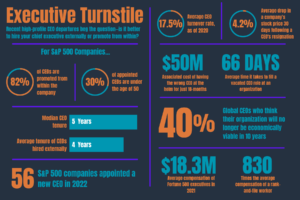Executive Turnstile: The Next CEO
Recent high-profile CEO turnover begs the question—is it better to hire your chief executive externally or promote from within?
Despite enjoying relatively stable leadership over the years, Salesforce recently found itself at the center of an executive turnover crisis.
In 2020, after 20 years as chief executive, co-founder Marc Benioff announced that he would be stepping back from day-to-day operations to focus on longer-term strategy and innovation and appointed former COO Keith Block as CEO. However, less than a year later, Block resigned as CEO citing personal reasons, with Benioff resuming his former role.
In November 2021, Benioff and Co. announced that Bret Taylor, who had previously served as chief operating officer and chief product officer would become co-CEO alongside Benioff. From all indications, Taylor—a key driving force behind Salesforce’s $27.7 billion takeover of workspace messaging platform Slack Technologies—seemed like the right pick for the job. Yet, in December 2022, Taylor announced his resignation, which was quickly followed by the news that then-Slack CEO, Stewart Butterfield, would also leave his post the following January.
In both cases, Taylor and Butterfield were innately familiar with their respective platforms long before ascending to chief executive officer and should have enjoyed much longer tenures in their roles. While CEO turnover is not necessarily negative and can sometimes play an important part in a company’s evolution and growth, Salesforce’s continued challenges beg the question—is it better to promote externally or internally, and what are the associated impacts of each?




